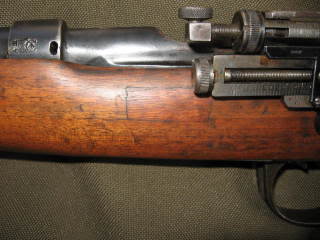-
Legacy Member

Ishapore Screw - Peter Laidler
I seem to remember a post from Peter on the 'old' CSP forum re the Ishapore screw and the fact that it was NOT only Ishapore that used it.
forum re the Ishapore screw and the fact that it was NOT only Ishapore that used it.
It was also used by the Brits / Malaya during some FTR's.
Did anyone keep a copy of the post or could Peter re-post ?
Thanks
Information
 |
Warning: This is a relatively older thread
This discussion is older than 360 days. Some information contained in it may no longer be current. |
|
-
-
03-22-2009 06:13 PM
# ADS
Friends and Sponsors

-
Briefly, our EY SMLE's that were in mobilisation store all had the infamous screw BUT it was actually 'designed/invented/developed' by the UK and is still listed in our EMER's. I saw two No4's with the mod about a year or so ago when some DP No4's were withdrawn from the cadets in the South West. It was to pevent the waste of otherwise serviceable fore-ends should they split longitudinally from the front trigger guard screw forwards
and is still listed in our EMER's. I saw two No4's with the mod about a year or so ago when some DP No4's were withdrawn from the cadets in the South West. It was to pevent the waste of otherwise serviceable fore-ends should they split longitudinally from the front trigger guard screw forwards
-
Thank You to Peter Laidler For This Useful Post:
-
-
FREE MEMBER
NO Posting or PM's Allowed

I do remember what you mentioned. What I seem to remember is Peter saying something to the effect that British armourers would sometimes remove the steel screw and replace it with a hardwood tapered dowel.
armourers would sometimes remove the steel screw and replace it with a hardwood tapered dowel.
-
That's correct. On a service No4, the screw was seen as a bit of a quick fix. Better to remove it, open up the split, squeeze modern wood adhesive into it , squeeze closed then force a tapered oak dowel into the hole.
If you were REALLY trying to impress the examiner or were on a trade test, you'd use a small dowel at the far end of the split too.
-
-
It's an old problem with civilian owners/shooters of old Enfields. Armourers would take great pride in the quality of their wood patching and equally great pride in repairing them butts/fore-ends/handguards with the most superb patches. But these things are almost frowned on in civilian circles.
As I said many moons ago, An Armourer would comment 'WOW, lok at those patches'. But a civilian would comment 'UGH ..... look at those patches'
'One mans meat is another mans poison' as they say!
As matter of interest, do many forumers keep the original wood patches on their rifles through choice...................?
-
Thank You to Peter Laidler For This Useful Post:
-
Legacy Member

As matter of interest, do many forumers keep the original wood patches on their rifles through choice...................?
I like "my" patch - (just in front of the magazine) its part of the rifles history - just wish my woodworking skills were half as good.
-
-
I know what you mean Al and others. Some Armourers were absolute magicians..... I was crap and best left to the old rough and ready Bren guns. But I used to do the old L42 and No8 fore-ends just to keep my hand in.
-
-
Advisory Panel


Further to patching - if damaged woodwork needs to be repaired, I suppose there are two ways of approaching it these days: try for a near invisible epoxy repair, or perform an armourer style inlay.
From time to time stocks salvaged from Indian DP rifles are reused. These have semicircular cuts in the woodwork where the pin was set through the barrel and welded in. I have seen these cuts reparied with semicircular patches. This has a poor appearance, and simply announces the origin of the replacement stock. If an armourer style dovetailed inlay is used, the repair looks correct and period.
-
-
Deceased August 31st, 2020

What a wonderful medium wood is to work with. Armourers would find it a challenge today if they had to patch plastic (which they may do. Pass the bondo!)

Last edited by englishman_ca; 03-23-2009 at 09:29 AM.
Reason: cant spel
-
-
FREE MEMBER
NO Posting or PM's Allowed


Originally Posted by
Alan de Enfield

I like "my" patch - (just in front of the magazine) its part of the rifles history - just wish my woodworking skills were half as good.
Ditto. I would only add the patches add a "human" factor indicating at some time in the dim past skilled hands were tending to my rifle. I consider patches sort of personalize a rifle. One question for Peter. What specialized tools were employed to do these patches so very precisely? Obviously they were razor sharp!!! Could someone who may have a set of them post some pics??
forum re the Ishapore screw and the fact that it was NOT only Ishapore that used it.















 PM
PM












